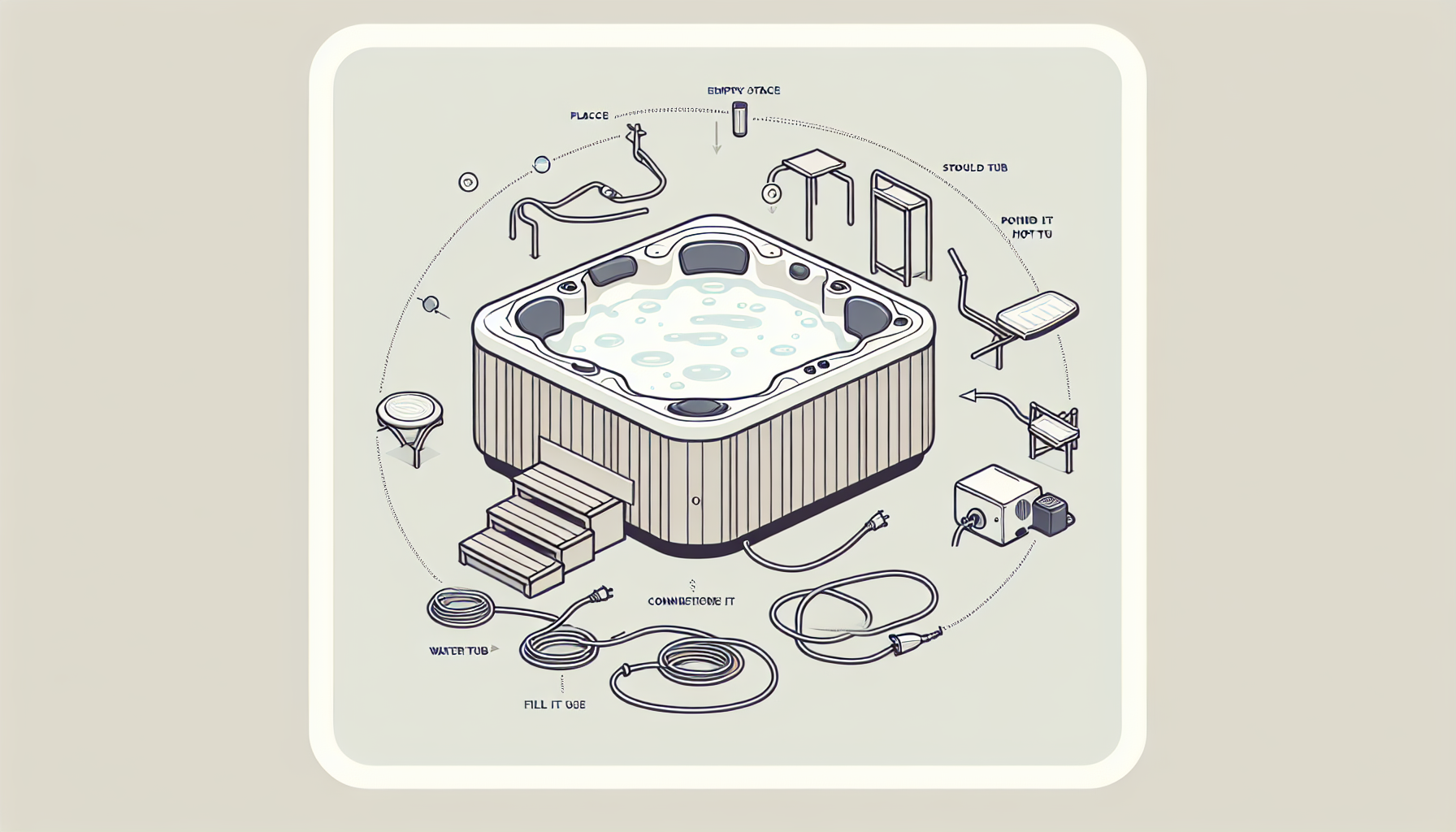Setting Up Your Hot Tub
Before you can relax in your new hot tub, you’ll need to decide if you want to install it indoors or outdoors. Both options have their perks and drawbacks, so let’s dive into what works best for your Northwestern Wisconsin home.
Indoor vs. Outdoor Installation
When you’re planning your hot tub setup, choosing between an indoor or outdoor location is crucial. Each option has its own benefits and things to think about.
Indoor Installation
- Privacy: Keep your soak sessions private. No nosy neighbors here!
- Temperature Control: An indoor setup keeps the water hot without sky-high energy bills.
- Protection from Elements: Bugs, dirt, leaves? Practically non-existent indoors, meaning cleaner water and a longer lifespan for your hot tub’s cover and cabinet.
Outdoor Installation
- Scenic Views: Whether it’s a clear starry night or bright sunny day, outdoor tubs offer a relaxing escape with nature as your backdrop.
- Space and Ventilation: Outdoors, you don’t have to worry about fitting your tub into a confined space or dealing with stuffy air full of chemical fumes.
Benefits of Indoor Hot Tubs
Installing your hot tub indoors has some pretty sweet advantages for a lot of folks.
| Benefit | Description |
|---|---|
| Privacy | Your hot tub time stays your hot tub time. No peeping neighbors to intrude. |
| Consistent Temperature | Indoor setups make it easier to keep your tub’s temperature steady, reducing energy use and cutting down on your bills. |
| Protection from Elements | Being indoors protects your tub from weather, pests, and grime, helping it stay clean and last longer. |
But remember, indoor setups need proper ventilation to avoid damp conditions and mold. Use water-resistant materials for walls and floors to dodge condensation damage (Better Homes & Gardens).
Dive into our full hot tub installation guide for everything you need to know about setting up your tub indoors or outdoors. Our guide walks you through all the steps and tips for smooth installation.
With this info, folks in Eau Claire, Menomonie, and Chippewa Falls can easily figure out the best setup for their new hot tub. Check out our detailed hot tub setup instructions for more advice on getting your spa ready to go.
Hot Tub Maintenance Basics
Keep your hot tub sparkling, safe, and fun with some straightforward upkeep. Dive into the essentials of water chemistry and cleaning to keep your oasis in prime shape.
Water Chemistry Essentials
Balanced water chemistry is like the secret sauce to a pleasant soak. Mess it up, and you’re looking at murky water, itchy skin, and other not-so-fun stuff.
Keep an Eye on These:
- pH Levels: Target a pH between 7.4 and 7.6. Too high or too low, and the water gets nasty. Use pH adjusters like a seasoned chef tweaks seasonings.
- Alkalinity: Shoot for 100 to 150 parts per million (ppm). It acts as a bodyguard for the pH, preventing wild swings. Baking soda is your friend here.
- Sanitizer Levels: Chlorine or bromine should do the job. Weekly checks keep bacteria at bay. Don’t skimp—no one wants a bacteria bath.
- Calcium Hardness: Aim for 150 to 250 ppm. Keeps things from corroding or scaling up. Think of it as an anti-aging serum for your hot tub.
| Chemical | Ideal Range |
|---|---|
| pH | 7.4 – 7.6 |
| Alkalinity | 100 – 150 ppm |
| Calcium Hardness | 150 – 250 ppm |
Routine Tips:
- Test the water weekly with strips or a fancy digital tester.
- Add sanitizer and shock the water after it’s been sitting idle.
- Regularly tweak the pH and alkalinity to keep that perfect balance.
Check out our hot tub setup guide for a deep dive into balancing water like a pro.
Cleaning and Filter Care
The cleaning game keeps your hot tub smooth and long-lived. Stick to these steps, and you’re gold.
Key Cleaning Moves:
- Weekly Scrub: A sponge and some white vinegar are all you need. Wipe down the shell and jets to keep things fresh.
- Filter Maintenance: Water circulates through cartridge filters that you should hose down. Automatic cycles are a breeze; if not, manually run the filter twice a day for about 15 to 20 minutes.
- Quarterly Deep Clean: Every three to four months, drain, scrub, and clean every nook and cranny. Use the right cleaning solutions for a thorough job.
For more on keeping things tidy, peek at our hot tub installation checklist.
| Task | Frequency |
|---|---|
| Shell and Jets Cleaning | Weekly |
| Filter Circulation | Daily |
| Deep Cleaning | Every 3-4 months |
Stick to these water chemistry and cleaning tips, and your hot tub will always be ready for action. Need more nuggets of wisdom? Head over to our hot tub setup instructions and hot tub tips for beginners.
Electrical Needs for Your Hot Tub
Let’s talk about something super important—getting your hot tub’s electrical setup right. You want to relax and have fun, not worry about blowing a fuse or—heaven forbid—getting zapped.
Types of Electrical Setups
Hot tubs basically come in two flavors: hard-wired and plug-and-play.
- Traditional Hard-Wired Hot Tubs
- Operate on 240 volts, like big appliances.
- Need a dedicated circuit, 40-60 amps.
- Gotta have a GFCI-protected breaker for safety. Trust me on this one—safety first.
- Plug-and-Play Hot Tubs
- Run on 120 volts—standard stuff.
- Hook up to a regular 15-20 amp GFCI-protected outlet.
- Super easy to set up and move around. Big bonus if you’re renting or like rearranging.
| Electrical Setup Type | Voltage | Circuit Requirement | GFCI Protection | Portability |
|---|---|---|---|---|
| Hard-Wired Hot Tubs | 240V | 40-60 Amp | Yes | Fixed |
| Plug-and-Play Hot Tubs | 120V | 15-20 Amp | Yes | High |
For the nitty-gritty details, check out our electrical setup guide.
Why Proper Wiring Matters
Good wiring is more than just flipping a switch. It’s about keeping things running smoothly and safely. Here’s what you need to know:
- Follow the Rules: National Electric Code and local codes are basically the law of the land. A licensed electrician will make sure you’re all set and not just winging it.
- GFCI Protection: This thing saves lives by stopping electrical currents if something goes wrong. Just make sure both the hot tub and the breaker are GFCI protected.
- Dedicated Circuit: Especially for the hard-wired tubs, you need a circuit that’s all its own. No sharing with other power-hungry gadgets.
- Hire a Pro: Trust us, this isn’t a DIY project. Get a licensed electrician to handle the installation. Your stress levels will thank you.
Getting your hot tub wired correctly sets you up for stress-free soaks. For a hassle-free dive into hot tub life, check out our full installation guide.
Getting Your Hot Tub Ready: Easy Steps Explained
Seven Simple Steps to Set Up Your Hot Tub
Getting your hot tub up and running isn’t rocket science. Just follow these straightforward steps to get everything in place:
- Pick the Best Spot: Find a flat area that can handle the weight of your hot tub with water in it. Make sure there’s good drainage to avoid puddles.
- Clear the Area: Clean up any debris and ensure the ground is level. You might need a concrete slab or a sturdy deck.
- Place the Hot Tub: Carefully situate your hot tub on the prepared surface, following the manufacturer’s instructions.
- Hook Up the Electricals: Let a professional electrician handle this part. They’ll wire your tub to a dedicated GFCI circuit breaker safely.
- Fill It Up: Use a garden hose to fill your hot tub. Stick the hose in the filter area to avoid trapping air in the pump.
- Balance the Chemicals: Test your water’s pH, alkalinity, and sanitizer levels, and adjust as needed. For more info, check out our water chemistry basics.
- Start the Pump and Heater: Turn on your hot tub to circulate the water and mix the chemicals. This also gets the water heated to your desired temp.
| Step | Description |
|---|---|
| 1 | Pick the Best Spot |
| 2 | Clear the Area |
| 3 | Place the Hot Tub |
| 4 | Hook Up the Electricals |
| 5 | Fill It Up |
| 6 | Balance the Chemicals |
| 7 | Start the Pump and Heater |
Want more details on each step? Check out our complete hot tub installation guide.
Keeping the Water Levels Just Right
Having the right water level in your hot tub is key for everything to run smoothly. Mess this up, and you could damage the pumps and heaters.
- First Time Filling: Fill your hot tub so that the water reaches halfway up the skimmer or filter intake for proper circulation.
- Regular Check-Ups: Keep an eye on the water level, especially after using the hot tub a lot. Water can evaporate or splash out, so you might need to add more.
- Topping It Off: If the water level is low, add water with a garden hose. Don’t forget to test and balance the water chemistry afterwards. For extra help, see our cleaning and filter care guide.
- Low Water Warnings: Modern hot tubs often have low water indicators. These can be visual markers or electronic sensors.
Keeping the water level right, along with regular cleaning and chemical balancing, will make sure your hot tub runs well and lasts long. For more handy tips, check out our hot tub setup tips and tricks.

